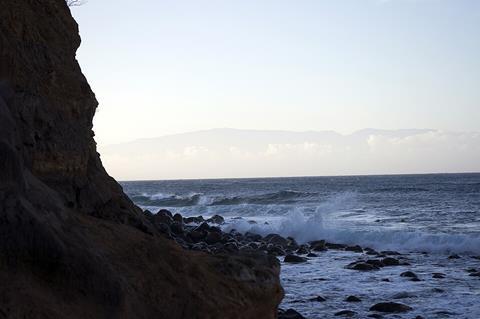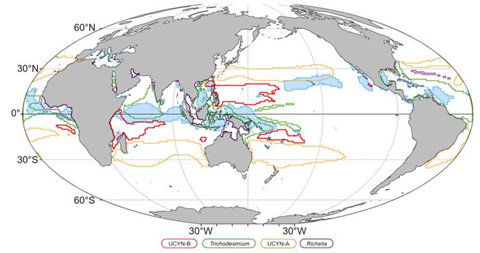A research team led by Professor Dalin Shi at the State Key Laboratory of Marine Environmental Science, Xiamen University, together with collaborators from GEOMAR Helmholtz Centre for Ocean Research Kiel, reports that the cyanobacterium UCYN-B plays an important role in marine nitrogen (N2) fixation.

The team shows that UCYN-B drives high N2 fixation rates in previously unrecognized hotspots accross the global ocean, making a significant contribution to the ocean’s nitrogen supply and productivity. The study draws on extensive field surveys that combined stable isotope tracing, high-throughput sequencing, quantitative PCR (qPCR), and advanced statistical modeling.
READ MORE: Nitrogen fixation on marine snow particles is widespread in the world’s oceans
READ MORE: Long-standing marine mystery solved: How algae get nitrogen to grow
Since the industrial revolution, the ocean has absorbed about 30% of human-produced carbon dioxide (CO2). A key process behind this carbon storage is the biological carbon pump, which depends on phytoplankton photosynthesis. However, more than half of the ocean’s primary production is limited by the shortage of fixed nitrogen.
Diazotrophs, microorganisms capable of converting atmospheric N2 into bioavailable nitrogen, are therefore essential in nutrient-poor regions and play a critical role in climate regulation. Yet direct in situ measurements of N2 fixation remain scarce, limiting accurate estimates of its global flux and its links to the carbon cycle.
Oceanic sink
The North Pacific Subtropical Gyre (NPSG), the largest contiguous ecosystem on Earth and a major oceanic sink of atmospheric CO2, is often described as an “ocean desert” due to extremely low nutrient levels. In this region, biological N2 fixation is an important nitrogen source supporting productivity.

While most previous work focused on Station ALOHA in the central North Pacific, little was known about other parts of the vast gyre. Limited observations have suggested substantial spatial variability in N2 fixation rates and diazotrophs community structure, leaving a gap that could affect global N2 fixation estimates and, in turn, predictions of ocean carbon storage.
Nitrogen fixation
Professor Shi’s team conducted large-scale, high-resolution surveys in the western North Pacific and found that UCYN-B dominates the diazotroph community there. Depth-integrated N2 fixation rates ranged from 199 to 821 μmol N m-2 d-1 in summer, comparable to other known global hotspots.
Quantitative analyses, including size-fractionated N2 fixation rate measurements, nifH gene sequencing, metagenomics, and qPCR, show that UCYN-B accounted for 67–99% of the diazotroph population at stations with high N2 fixation rates and was estimated to contribute about 90% of total N2 fixation in the study region.
By combining global genetic dataset with environmental data from Earth system models, the team characterized the ecological niche of UCYN-B using generalized additive models (GAMs). Results show that UCYN-B thrives in warm, nutrient-poor waters, tolerates low dissolved iron, and depends on phosphorus availability. Simulations indicate that UCYN-B is not only abundant in the western North Pacific but also widespread in other (sub)tropical oligotrophic oceans, including the western South Pacific, western Indian Ocean, and South Atlantic.
Significant contributor
The study provides the first quantitative global assessment of UCYN-B’s contribution to oceanic N2 fixation. Key findings include: (1) Regional role: UCYN-B contributes 5.2–7.2 Tg N yr-1 of N2 fixation in the western North Pacific; (2) Global impact: UCYN-B-dominated regions collectively contribute 10.8–15.0 Tg N yr-1, about 20% of the global oceanic N2 fixation flux; (3) Indian Ocean hotspot: UCYN-B accounts for 3.4–4.8 Tg N yr-1 in the Indian Ocean, nearly ten times higher than earlier estimates, and represents 45-52% of the region’s N2 fixation. These results highlight the significant role of UCYN-B in the marine nitrogen fixation and expose limitations in earlier modeling approaches.
This work shows that UCYN-B is a dominant driver of biological N2 fixation at basin and global scales. It provides, for the first time, predictive maps and quantitative estimates of N2 fixation in UCYN-B dominated regions.
The findings indicate that UCYN-B’s role has been substantially underestimated in current models, leading to gaps in understanding global nitrogen and carbon cycles. By clarifying the environmental controls on diazotrophic cyanobacteria and simulating their global distribution, this study offers a stronger basis for predicting how marine N2 fixation, and by extention, the oceanic carbon sink may respond to climate change.




No comments yet